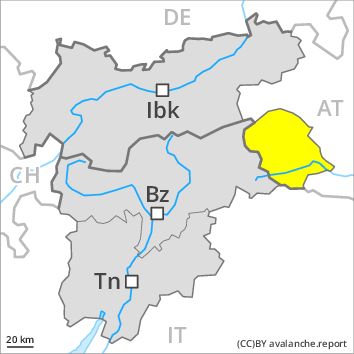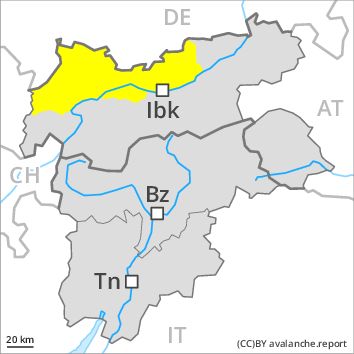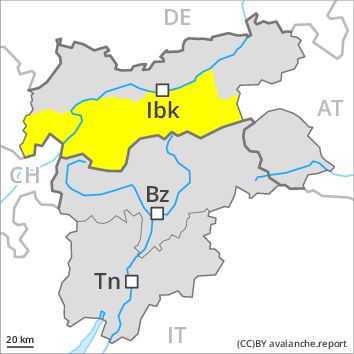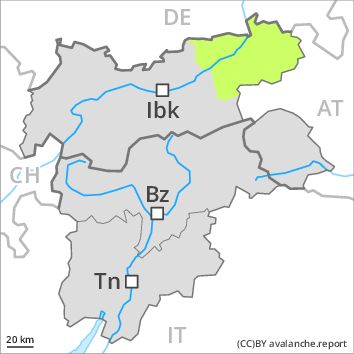Regions
Glockner Range, Eastern Deferegger Alps, Schober Mountains, Lienzer Dolomites, Venediger Range, Eastern Rieserferner Mountains

Danger level
Danger Level 2 - Moderate
Avalanche Problem
Wind-drifted snow above 2600m, N-NE-NW
Gliding snow above 2600m, E-SE-S-SW-W

Wind slabs require caution, especially adjacent to ridgelines.
The more recent wind slabs can be released, especially by large additional loads, in particular on northwest to north to northeast facing aspects above approximately 2600 m. Mostly avalanches are medium-sized. The avalanche prone locations are to be found in particular adjacent to ridgelines. They are rather rare and are clearly recognisable to the trained eye. The wind slabs in very steep terrain are to be bypassed. Transitions from a shallow to a deep snowpack are unfavourable.
Slight increase in danger of gliding avalanches as a consequence of warming during the day. Small to medium-sized gliding avalanches are possible. This applies in particular on steep grassy slopes, especially on east, south and west facing slopes below approximately 2600 m, but in isolated cases also on steep shady slopes below approximately 2000 m.
As a consequence of warming during the day and solar radiation more small and, in isolated cases, medium-sized moist loose snow avalanches are possible.
Snowpack
dp 6: cold, loose snow and wind
dp 2: gliding snow
The snowpack will be subject to considerable local variations at high altitudes and in high Alpine regions. The more recent wind slabs have bonded quite well with the old snowpack. Wind slabs are lying on soft layers, in particular on shady slopes at high altitudes and in high Alpine regions. The snowpack will become increasingly moist, especially on very steep sunny slopes below approximately 2800 m.
Tendency
Slight increase in danger of gliding avalanches.
Regions
Karwendel Mountains, Western Lechtal Alps, Central Lechtal Alps, Grieskogel Mountains, Allgäu Alps, Eastern Lechtal Alps - Ammergau Alps, Mieming Mountains

Danger level
Danger Level 2 - Moderate
Avalanche Problem
Wind-drifted snow above 2200m, N-NE-E-W-NW
Gliding snow above 2600m, E-SE-S-SW-W

Wind slabs require caution, especially adjacent to ridgelines.
The more recent wind slabs can be released, especially by large additional loads, in particular on west to north to east facing aspects above approximately 2200 m. Mostly avalanches are medium-sized. The avalanche prone locations are to be found in particular adjacent to ridgelines. They are clearly recognisable to the trained eye. The wind slabs in very steep terrain are to be bypassed. Transitions from a shallow to a deep snowpack are unfavourable. Dry avalanches can in some places be released in the old snowpack, even by small loads in isolated cases. This applies in particular on very steep shady slopes between approximately 1900 and 2300 m.
Slight increase in danger of gliding avalanches as a consequence of warming during the day. Small to medium-sized gliding avalanches are possible. This applies in particular on steep grassy slopes, especially on east, south and west facing slopes below approximately 2600 m, but in isolated cases also on steep shady slopes below approximately 2000 m.
As a consequence of warming during the day and solar radiation more small and, in isolated cases, medium-sized moist loose snow avalanches are possible, in particular on rocky slopes below approximately 2800 m.
Snowpack
dp 6: cold, loose snow and wind
dp 2: gliding snow
The snowpack will be subject to considerable local variations at high altitudes and in high Alpine regions. The more recent wind slabs are in isolated cases prone to triggering. The somewhat older wind slabs have bonded quite well with the old snowpack. Wind slabs are lying on soft layers, in particular on shady slopes at high altitudes and in high Alpine regions. The snowpack will become increasingly moist, especially on very steep sunny slopes below approximately 2800 m.
Tendency
Slight decrease in danger of dry avalanches. Slight increase in danger of gliding avalanches.
Regions
Western Tuxer Alps, Eastern Tuxer Alps, Glockturm Range, Weißkugel Range, Western Verwall Mountains, Gurgler Range, Central Stubai Alps, Eastern Verwall Mountains, Northern Zillertal Alps, Silvretta, Samnaun Mountains, Northern Oetz and Stubai Alps

Danger level
Danger Level 2 - Moderate
Avalanche Problem
Wind-drifted snow above 2400m, N-NE-E-W-NW
Gliding snow above 2600m, E-SE-S-SW-W

Fresh wind slabs require caution, especially adjacent to ridgelines.
The wind will be moderate to strong in the regions exposed to the foehn wind. In particular in the regions exposed to the foehn wind mostly small wind slabs will form. The more recent wind slabs can be released by a single winter sport participant in isolated cases on west to north to east facing aspects above approximately 2400 m. Caution is to be exercised at their margins in particular. The avalanche prone locations are to be found in particular adjacent to ridgelines. They are and are clearly recognisable to the trained eye. The wind slabs in very steep terrain are to be bypassed.
Dry avalanches can additionally be released in deeper layers. This applies in particular on steep south facing slopes above approximately 2800 m as well as on steep west, north and east facing slopes above approximately 2400 m. In particular transitions from a shallow to a deep snowpack are unfavourable. Mostly avalanches are medium-sized.
Slight increase in danger of gliding avalanches as a consequence of warming during the day. Small to medium-sized gliding avalanches are possible. This applies in particular on steep grassy slopes, especially on east, south and west facing slopes below approximately 2600 m, but in isolated cases also on steep shady slopes below approximately 2000 m. As a consequence of warming during the day and solar radiation more small and, in isolated cases, medium-sized moist loose snow avalanches are possible.
Snowpack
dp 6: cold, loose snow and wind
dp 2: gliding snow
The snowpack will be subject to considerable local variations at high altitudes and in high Alpine regions. The somewhat older wind slabs have bonded quite well with the old snowpack. The more recent wind slabs are lying on soft layers in particular on shady slopes at high altitudes and in high Alpine regions. The fresh wind slabs can be released in isolated cases. Faceted weak layers exist in the old snowpack in particular in areas where the snow cover is rather shallow. This applies in particular adjacent to ridgelines as well as on steep east, south and west facing slopes at high altitudes and in high Alpine regions. The snowpack will become increasingly moist, especially on very steep sunny slopes below approximately 2800 m.
Tendency
Slight decrease in danger of dry avalanches. Slight increase in danger of gliding avalanches.
Regions
Brandenberg Alps, Western Kitzbühel Alps, Wilder Kaiser Mountains - Waidring Alps, Eastern Kitzbühel Alps

Danger level
Danger Level 1 - Low
Avalanche Problem
Gliding snow, E-SE-S-SW-W

Gliding snow requires caution.
A danger of gliding avalanches and moist snow slides exists. This applies in particular on steep grassy slopes, especially on east, south and west facing slopes, but in isolated cases also on steep shady slopes below approximately 2000 m. Areas with glide cracks are to be avoided. Small to medium-sized gliding avalanches are possible.
As a consequence of warming during the day and solar radiation more small and, in isolated cases, medium-sized moist loose snow avalanches are possible.
The more recent wind slabs can be released in isolated cases, but mostly only by large additional loads, in particular on extremely steep shady slopes at high altitude. Restraint should be exercised because avalanches can sweep people along and give rise to falls. The avalanche prone locations are clearly recognisable to the trained eye.
Snowpack
dp 2: gliding snow
The various wind slabs have bonded generally well together. The snowpack will become increasingly stable. This also applies at high altitude. The snowpack will become increasingly moist, in particular on very steep sunny slopes.
Tendency
Currently there are quite favourable conditions generally.




